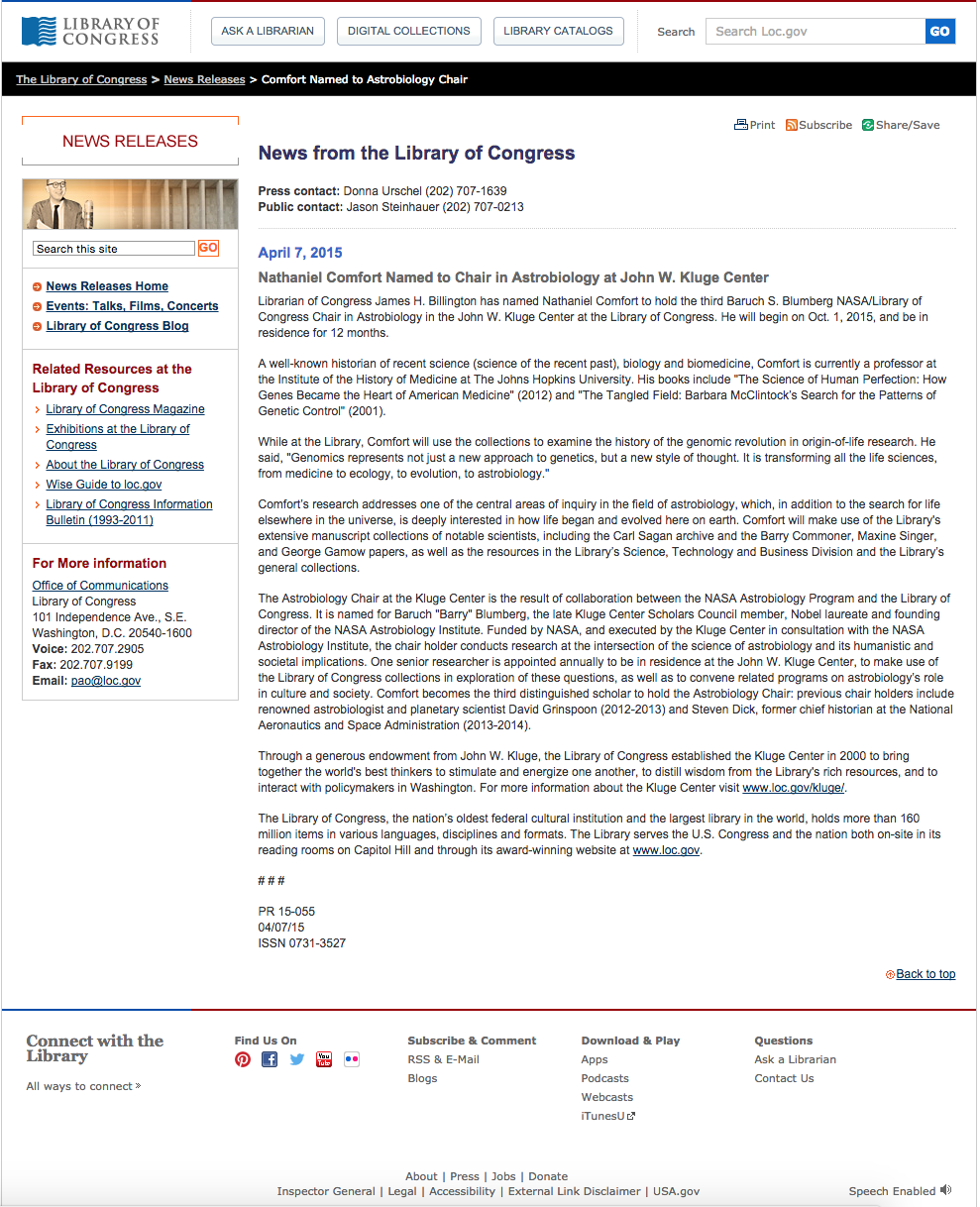“Nobel scientist Tim Hunt: female scientists cause trouble for men in labs. English biochemist tells conference women in laboratories ‘fall in love with you and when you criticise them, they cry’” (The Guardian)
“I did mean the part about having trouble with girls… I’m really, really sorry I caused any offence, that’s awful. I certainly didn’t mean that. I just meant to be honest, actually.” (Tim Hunt)
Stockholm, 1983. A certain English scientist whose surname rhymes with…let’s go with a small boat that you pole along the river Cam…is 40 years old. He has received an invitation to the Nobel festivities honoring the geneticist Barbara McClintock, “for her discovery of mobile genetic elements.” He fancies himself a pick-up artist and thinks this will be an excellent place to meet girls. He starts at the top.

BMC: And so, Your Majesties, Your Royal Highnesses, Ladies and Gentlemen, in conclusion, I wish to thank you and the Swedish people for their many courtesies. I hope I have conveyed some of the joy of the marvelous maize plant and the startling phenomena of the genome that one can discover when one has the time and the solitude to watch and to think. Are there any questions?
TH (aside, to companion): Watch this. Observe the master.
(to McClintock): Yes, thank you. Before I speak, I’d like to say something: that’s a smashing dress.
BMC: I hate dresses. They said I had to wear one, so I wore one. My niece found it somewhere near here.
TH: Ahem, yes, I see. Well, jolly good one on me then!
[You see? She’s falling for me. Works every time.]
What I wanted to say was, all of these elegant trappings notwithstanding, that I find your argument…unconvincing. You haven’t shown any data of any sort that a contemporary biologist would recognize.
BMC: Are there any questions?
TH: [Always compliment them, then insult them a little. Never fails. Watch.]
What I mean is, I don’t mean to be indelicate, but what gives you the right to make such claims?
BMC: What gives me the right, or what basis do I have? Please be clear. Well I can address both. What gives me the right is fifty years of studying genetics and the fact that I’m standing at the Nobel podium. The basis for my claims is my data, which I just reviewed. Weren’t you paying attention? Are there any other questions? Yes, you in the back…
TH: [Ouuuuch! <grins> God I love older women! They find me irresistible!]
Later, at the Banquet…
TH: (suavely) Ah! Dr. McClintock!
BMC: Yes.
TH: I just wanted to apologize for my remarks at your lecture.
BMC: Yes.
TH: I ought not to have been so candid in such a public forum.
BMC: No.
TH: I mean, I don’t honestly see what all the fuss is about your work. but I ought not to have said so in front of all of those reporters and, you know, the King and all. I hope I didn’t upset you. I just wanted to be honest.
BMC: You’re the one who looks foolish. Did I upset you?
TH: You…me…? I…
BMC: Your pronouns seem to be functioning normally. But haven’t you any verbs? I would have thought Cambridge would teach you better English.
TH: Now look here. There’s no call to be insulting.
BMC: Oh, don’t take me too seriously. Turn sideways. [casts her eyes downward] I’ll give you this: you have a nice tush. [pats it][1]
TH: WHAT?!? I never!
BMC: Never? Too bad. Me neither…much. Never had the time. I was just too interested in chromosomes—and the Y is so short and stubby and dull. I do enjoy looking at a good tush, though.
TH: You never fell in love? Say, with a charming professor, aloof yet alluring, with beguiling nostril hair?
BMC: [snorts] Good one. Maybe you’re all right, Tom.
TH: Tim. Timothy.
BMC: Suit yourself. If I may be frank, I could never feel attracted to someone I thought wasn’t as smart as I am. And, well,…
TH: [stiffens] Really! Now listen, what I need to tell you is this: Your experiments are just so baroque. You practice this old-fashioned style of genetics, your writing’s impenetrable, and your experiments! They’re so complicated—one has to learn half your maize strains and strange chromosome constructions just to grasp your hypothesis! I can’t honestly imagine how the Nobel committee even followed your work, let alone evaluated it. Why don’t you do some molecular experiments? Things become so much simpler!
BMC: Yes. As I was saying…
TH: Are you implying that I’m not…???
BMC: Must I spell it out for you? If you’re not clever enough to grasp what I’m doing, why are you even here? God I hate these stuffed-shirt evenings!
TH: Now look here, madam!
BMC: No. You look here, squirt. And be quiet. I don’t mean you any harm—you’re no dumber than most of the other men I’ve spent my career around. But you’re no smarter either. I’ve been listening to you for ten minutes now, and you haven’t said a single intelligent thing. Don’t you ever grow up? There are more interesting punchbowls in this room. And I’ve had plenty of your Australopithecine views. That’s A-U-S…
[At this, TH’s eyes start to well] T-R-A-L-O-P-I-T-H-E-C-I-N-E. There!
BMC: Gold star. [rolls eyes] Tom, I’m sure what you do is perfectly interesting to someone. And maybe—although of this I’m less certain—what you say, someone finds charming. But with me, neither happens to be the case. Now, about that punch… [walks off]
[Tears stream down TH’s cheeks. He falls to his knees, one arm extended melodramatically in her direction] Barbara! Dr. McClintock! Don’t go! I—I love you!
BMC: [To another, female, guest] My trouble boys is that all they want to talk about is romance and their own feelings. Always falling in love with you and weeping. How do they ever get any science done?
[1] McClintock was known to compliment people—men and women—on their tushes. In the words of a long-time friend, “She just liked tushes.”
Like this:
Like Loading...
 Feature requests for version 2.0: Instagram sonogram upload, a financial planner to help you save for college, and the ability to choose a parenting style: Tiger Mother, Free-range, or Yuppie Helicopter.
Feature requests for version 2.0: Instagram sonogram upload, a financial planner to help you save for college, and the ability to choose a parenting style: Tiger Mother, Free-range, or Yuppie Helicopter.




 Why astrobiology? My next project is a biography of DNA. One key part of the book will be the story of how we’ve come to understand the origins of DNA and the origin of life in an RNA world. So I’ll be using the unparalleled resources of the Library to write the history of origins research since the genome project, as well as working on the rest of the book.
Why astrobiology? My next project is a biography of DNA. One key part of the book will be the story of how we’ve come to understand the origins of DNA and the origin of life in an RNA world. So I’ll be using the unparalleled resources of the Library to write the history of origins research since the genome project, as well as working on the rest of the book.
 For those up to the challenge, the park promises to get your pulse racing. At any moment, Benito Mussolini, Josef Stalin, Idi Amin, Pol Pot, or even Hitler himself may pop out from behind a tree and attempt to
For those up to the challenge, the park promises to get your pulse racing. At any moment, Benito Mussolini, Josef Stalin, Idi Amin, Pol Pot, or even Hitler himself may pop out from behind a tree and attempt to
You must be logged in to post a comment.